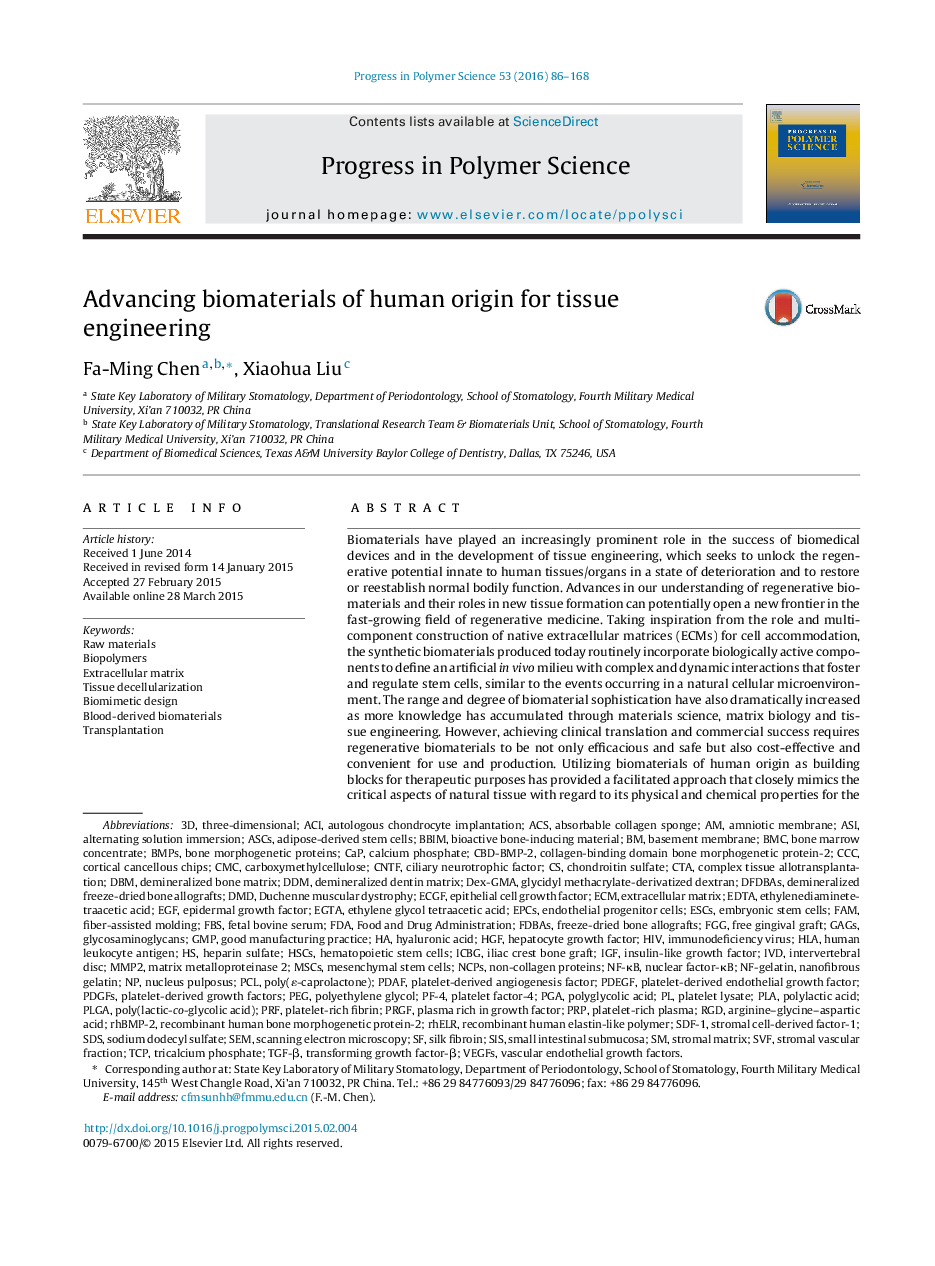| کد مقاله | کد نشریه | سال انتشار | مقاله انگلیسی | نسخه تمام متن |
|---|---|---|---|---|
| 5207984 | 1503003 | 2016 | 83 صفحه PDF | دانلود رایگان |
عنوان انگلیسی مقاله ISI
Advancing biomaterials of human origin for tissue engineering
ترجمه فارسی عنوان
پیشرفت مواد بیولوژیکی منشاء انسانی برای مهندسی بافت
دانلود مقاله + سفارش ترجمه
دانلود مقاله ISI انگلیسی
رایگان برای ایرانیان
کلمات کلیدی
ECMPLGANF-κBASCsEGFIGFSDSFBSCMCPGAPCLThree-dimensionalPRFFAMDDMCCCCTAMSCsPLAACSBMCEGTARGDTricalcium phosphateSDF-1CNTFGMPSISASIPrPEPCsDMDrhBMP-2DBMHGFGAGsPRGFHSCsMMP2ESCsECGFIVDFGGSVFabsorbable collagen spongePF-4free gingival graftFDAVEGFsdemineralized dentin matrixTGF-βICBGNCPsBMPs - BMP هاHuman leukocyte antigen - آنتی ژن لوسکسی انسانHLA - آنتیژن گلبول سفید انسانیEDTA - اتیلن دی آمین تترا استیک اسید ethylene glycol tetraacetic acid - اتیلن گلیکول تتراستیک اسیدEthylenediaminetetraacetic acid - اتیلینیدامین تتراستیک اسیدIliac crest bone graft - استخوان استخوان Iliac craterarginine–glycine–aspartic acid - اسید آرژنین گلیسین آسپارتاتیکHyaluronic acid - اسید هیالورونیکpolyglycolic acid - اسید پلی گلیکولیکtransforming growth factor-β - تبدیل فاکتور رشد βGood Manufacturing Practice - تمرین تولید خوبDuchenne muscular dystrophy - دیستروفی عضلانی دوشنIntervertebral disc - دیسک بین مهرهایSmall intestinal submucosa - زیرابوکوس روده کوچکBiopolymers - زیست بسپارها یا بیوپلیمرهاFood and Drug Administration - سازمان غذا و داروsodium dodecyl sulfate - سدیم دودسیل سولفاتfetal bovine serum - سرم جنین گاوAdipose-derived stem cells - سلول های بنیادی حاصل از چربیhematopoietic stem cells - سلول های بنیادی خونسازMesenchymal stem cells - سلول های بنیادی مزانشیمیEndothelial progenitor cells - سلول های پیش ساز اندوتلیالEmbryonic stem cells - سلولهای بنیادی جنینیHeparin sulfate - سولفات هپارینBiomimetic design - طراحی بیومیدانهepidermal growth factor - عامل رشد اپیدرمیHepatocyte growth factor - عامل رشد هپاتوسیتplatelet factor-4 - عامل پلاکت 4vascular endothelial growth factors - عوامل رشد اندوتلیال عروقیAmniotic membrane - غشای آمنیوتیکbasement membrane - غشای پایهstromal cell-derived factor-1 - فاکتور 1 حاصل از استروما سلولInsulin-like growth factor - فاکتور رشد مانند انسولینciliary neurotrophic factor - فاکتور نوروتروفیک ciliarynuclear factor-κB - فاکتور هسته ای κBplatelet-derived growth factors - فاکتورهای رشد پلاکتیCalcium phosphate - فسفات کلسیمSilk fibroin - فیبرین ابریشمplatelet-rich fibrin - فیبرین غنی از پلاکتTCP - قرارداد هدایت انتقالDemineralized bone matrix - ماتریکس استخوان دمینرالیزه شدهExtracellular matrix - ماتریکس خارج سلولیmatrix metalloproteinase 2 - ماتریکس متالوپروتئیناز 2SEM - مدل معادلات ساختاری / میکروسکوپ الکترونی روبشیRaw materials - مواد خامScanning electron microscopy - میکروسکوپ الکترونی روبشیNucleus pulposus - هسته پالپوسPlatelet lysate - ورید لازاتImmunodeficiency Virus - ویروس نقص ایمنیHIV - ویروس نقص ایمنی انسانی Recombinant human bone morphogenetic protein-2 - پروتئین مورفوژنیک استخوان بازآفرینی انسان 2bone morphogenetic proteins - پروتئین های مورفوژنیک استخوانplatelet-rich plasma - پلاسمای غنی از پلاکت، PRP، پی آر پیPoly(ɛ-caprolactone) - پلی (ɛ-کاپرولاکتون)poly(lactic-co-glycolic acid) - پلی (اسید لاکتیک گلیکولیک)polyethylene glycol - پلی اتیلن گلیکولPolylactic acid - پلی لاکتیک اسید یا اسید پلیلاکتیکPEG - پلیاتیلن گلیکول Transplantation - پیوندAutologous chondrocyte implantation - پیوند کاندروسیت اتولوگaci - چشمcarboxymethylcellulose - کربوکسی متیل سلولزStromal vascular fraction - کسر عروق استروماCaP - کلاه لبه دارChondroitin sulfate - کندرویتین سولفاتBone marrow concentrate - کنسانتره مغز استخوانGlycosaminoglycans - گلیکوز آمینو گلیکان ها
موضوعات مرتبط
مهندسی و علوم پایه
شیمی
شیمی آلی
چکیده انگلیسی
Biomaterials have played an increasingly prominent role in the success of biomedical devices and in the development of tissue engineering, which seeks to unlock the regenerative potential innate to human tissues/organs in a state of deterioration and to restore or reestablish normal bodily function. Advances in our understanding of regenerative biomaterials and their roles in new tissue formation can potentially open a new frontier in the fast-growing field of regenerative medicine. Taking inspiration from the role and multi-component construction of native extracellular matrices (ECMs) for cell accommodation, the synthetic biomaterials produced today routinely incorporate biologically active components to define an artificial in vivo milieu with complex and dynamic interactions that foster and regulate stem cells, similar to the events occurring in a natural cellular microenvironment. The range and degree of biomaterial sophistication have also dramatically increased as more knowledge has accumulated through materials science, matrix biology and tissue engineering. However, achieving clinical translation and commercial success requires regenerative biomaterials to be not only efficacious and safe but also cost-effective and convenient for use and production. Utilizing biomaterials of human origin as building blocks for therapeutic purposes has provided a facilitated approach that closely mimics the critical aspects of natural tissue with regard to its physical and chemical properties for the orchestration of wound healing and tissue regeneration. In addition to directly using tissue transfers and transplants for repair, new applications of human-derived biomaterials are now focusing on the use of naturally occurring biomacromolecules, decellularized ECM scaffolds and autologous preparations rich in growth factors/non-expanded stem cells to either target acceleration/magnification of the body's own repair capacity or use nature's paradigms to create new tissues for restoration. In particular, there is increasing interest in separating ECMs into simplified functional domains and/or biopolymeric assemblies so that these components/constituents can be discretely exploited and manipulated for the production of bioscaffolds and new biomimetic biomaterials. Here, following an overview of tissue auto-/allo-transplantation, we discuss the recent trends and advances as well as the challenges and future directions in the evolution and application of human-derived biomaterials for reconstructive surgery and tissue engineering. In particular, we focus on an exploration of the structural, mechanical, biochemical and biological information present in native human tissue for bioengineering applications and to provide inspiration for the design of future biomaterials.
ناشر
Database: Elsevier - ScienceDirect (ساینس دایرکت)
Journal: Progress in Polymer Science - Volume 53, February 2016, Pages 86-168
Journal: Progress in Polymer Science - Volume 53, February 2016, Pages 86-168
نویسندگان
Fa-Ming Chen, Xiaohua Liu,
